Sojourn on Sikinos

“Sikinos, 41 square kilometres, with a permanent population of around 330, is the least developed of the larger Cycladic islands. This may be due to the fact that it didn’t have a ferry dock until the 1990s. Visitors had to jump from the lowered back doors of the ferries onto fishermen’s caiques—highly entertaining for locals when performed at night with a full backpack, but hardly conducive to mass tourism. No doubt, in the waters of the bay is to be found a rich seam of artefacts for future marine archaeologists to ponder. Only in the late 1980s did a bus service up to the main settlement replace mule transport or a stiff hour’s climb. Happily, the people of Sikinos have kept tourist development firmly under control.”—Michael House
Polemicist
By Michael House
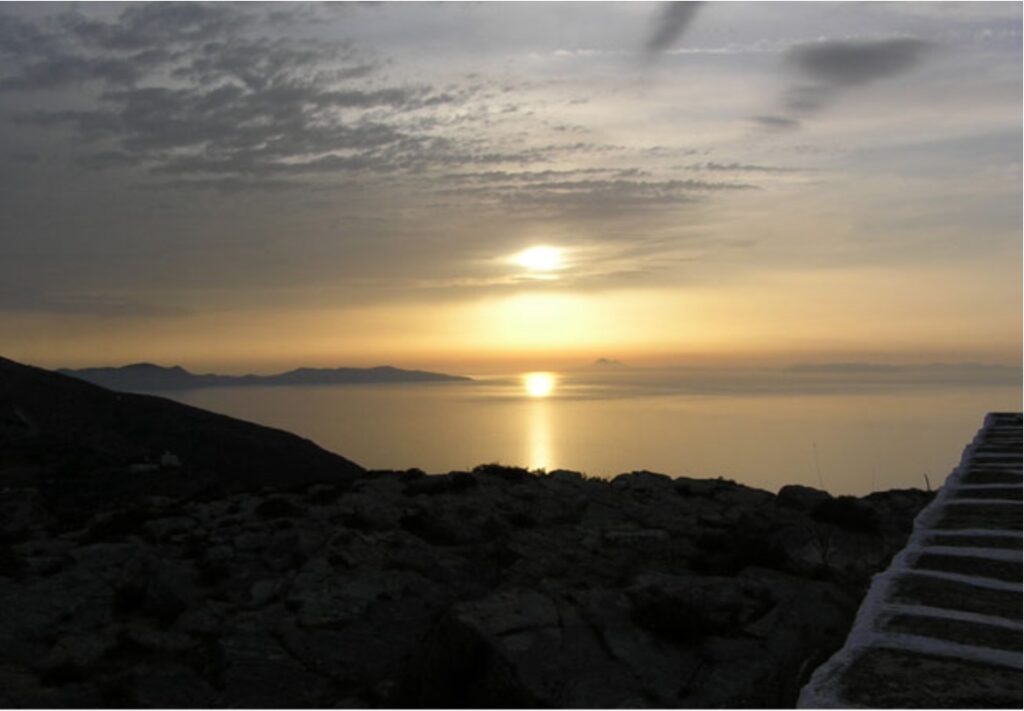
“A ship in a harbor is safe, but it not what ships are built for.”―John Augustus Shedd
Editor’s Note: For decades, I published a Greek travel website called “Greece Traveler: The Thinking Traveler’s Guide to Hellas” to whose readers Michael House, FRGS, sent back dispatches (illustrated by his own photographs) from far-flung Greek islands, where he traveled, pen in hand, mainly in the off-season. (House, a Fellow of The Royal Geographical Society, characterizes himself as “a criminal defense barrister, traveler, and travel writer who lived in Greece for three years in the 1980s, and has never fallen out of love with the country.” His last major expeditions comprised trekking in the Altai mountains of Mongolia and a walking tour in the Simien mountains of Ethiopia. When not at the ends of the earth, House lives in London and Northamptonshire.) Since “Greece Traveler” has now gone dark, permanently, I have resurrected House’s essays for serial publication here on “Hubris.” Καλό ταξίδι, to the back of Hellenic beyond!
WEST HAMPSTEAD London England—(Hubris)—September/October 2023—Sikinos is a secret everyone seems determined to keep. The Zante Line ferry, Adamantios Koraïs, runs there twice weekly in September, the only direct link with Piraeus. The Greek tourist information ferry schedule doesn’t list it. Nor does the weekly English-language paper, Athens Plus. The illuminated sign outside the Metro station at Piraeus lists the ferry but sends you in the wrong direction. It is a small miracle I got to Sikinos at all.
The ferry arrived at the uncivilized hour of 3:30 a.m. on Saturday (slightly better on Wednesdays: 1:30 a.m.). Rejecting offers of rooms—no point in going to bed for two hours—I walked up the hill out of the port to be greeted by a magnificent array of stars. The only comparable display I have seen was on the Mongolian steppe. Back at the port, I sat on a bench on the beach, watching the harbor lights reflecting on the gently lapping water. A pair of resident ducks floated on the ripples. Once, I heard the distant grumble of a motorcycle. At a quarter to five, a fishing boat juddered into life and chugged across the bay. Half an hour later, the first cock crowed.
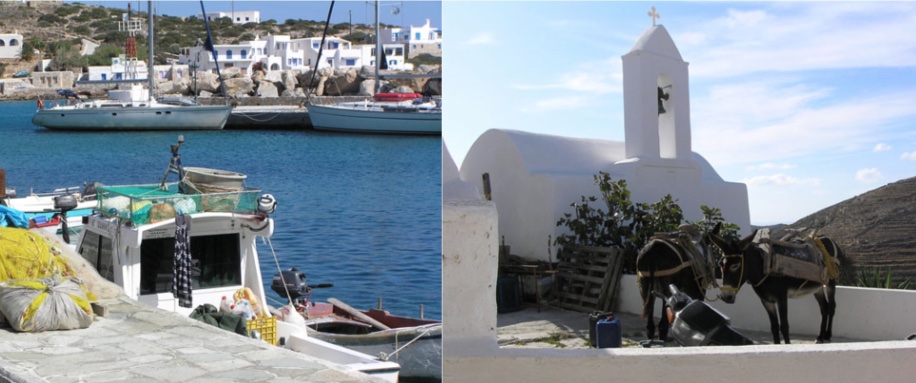
Sikinos, 41 square kilometres, with a permanent population of around 330, is the least developed of the larger Cycladic islands. This may be due to the fact that it didn’t have a ferry dock until the 1990s. Visitors had to jump from the lowered back doors of the ferries onto fishermen’s caiques—highly entertaining for locals when performed at night with a full backpack, but hardly conducive to mass tourism. No doubt, in the waters of the bay is to be found a rich seam of artefacts for future marine archaeologists to ponder. Only in the late 1980s did a bus service up to the main settlement replace mule transport or a stiff hour’s climb. Happily, the people of Sikinos have kept tourist development firmly under control.
Theodore and Mabel Bent (who now, incredibly “have” their own Facebook page)were intrepid Victorian travelers. They toured the Cyclades in the winter and spring of 1882, ending up on Sikinos in February. In his wonderful book, The Cyclades, or Life Among the Insular Greeks (1885), Theodore devoted a chapter to the island under the ominous title “Storm-Stayed at Sikinos.” The Bents’ caique captain left them and their Anafiote servant on the beach at what is now the port of Alpronia with the words, “There is no harbor in Sikinos.” Bent described the island as “a mere rock running down sheer into the waves [true of the north coast, only] about eight miles long by two wide.” The “mere rock” then supported a population of about 1,200. In contrast to the 30-odd craft I counted one morning at the port, Sikinos then boasted a single caique and “four rotten fishing-boats that will never venture in winter time a hunderd [sic] yards from the shore.” Mabel and Theodore waited four and a half hours in “one of the most solitary places I was ever in,” just “an indentation called a bay,” for mules to be fetched from the town. Eventually, their servant returned with transport.
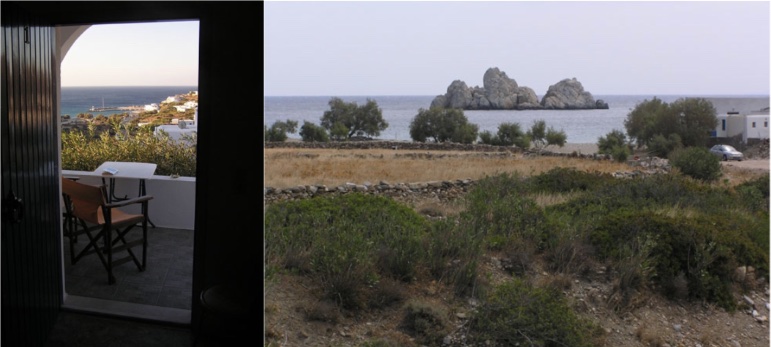
The Bents were not impressed by the inhabitants—of Cretan descent—who colonized the then-deserted island in the 16th century, to escape from Turkish oppression: “a very primitive race of people.” Nor did they think much of the “dirty Castro,” where they “sank ankle-deep in slush which in other countries would only have been encountered in a pigsty.” They would be startled today to see immaculate alleys covered with whitewashed circles and curlicues, the dazzling-white houses trimmed with doors and shutters of a deep blue. Theordore believed that these crude people, “mingling hardly at all with the outer world,” were “never likely to be disturbed by the advent of steamer or telegraph.” A hundred and twenty years later, Sikinos has the internet with broadband connections and at least ten ferries call per week thoughout the year.
However, one unchanging feature of Sikinos, which Bent warmly commended, is the warmth and hospitality of the people.
The main settlement sits on two sides of a plunging gorge: Hora, entirely residential, is on the left as you look up the valley, and Kastro, where the island’s main amenities are situated, is on the right. All around Kastro-Hora are abandoned terraces, often with the ruins of buildings, and supported by superbly-built dry-stone walling. The Bents saw the terraces as they were meant to be: “Every landowner in Sikinos has a garden outside the town, surrounded by a wall, in which he grows his vegetables and figs for household consumption, and containing buildings in which are his wine-press, his threshing floor, his mule stable and his store, where the produce of his country estate is housed, his honey, his corn, and his wine, and this is closed with a cleverly constructed wooden key.”
Unhappily, none of these storehouses survives intact.
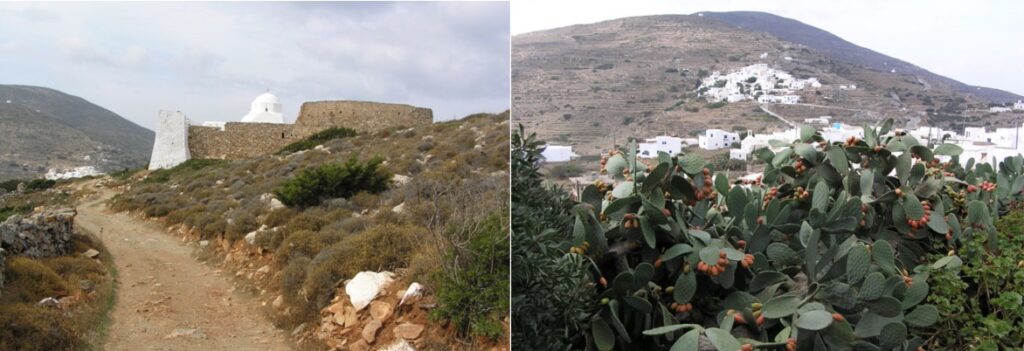
The earliest description of Kastro-Hora is by Ludwig Ross, the “Bavarocrat” founder of modern Greek archaeology. Visiting in 1837, he described the site of the capital thus: “It covered a precipitous height, fully one thousand eight hundred feet above the sea, and from the summit the rock goes down on the north side fully five hundred feet without a break. The rock is of blue marble, covered with a yellow lichen, which gives it an exceedingly rich appearance. Here and there out of the crevices grow thick bunches of wild mastic; ravens rush out of their eyries and croak; quantities of partridges, too, disturbed by the unwonted noise of human voices, take flight.”
There are two settlements on the island—the port of Apronia on the south coast, and Kastro-Hora, hidden in the hills away from the rapacious eyes of corsairs and Turkish overlords. Alpronia is, like every aspect of life here, laid-back and understated—so much so, indeed, that on my first morning, it was well after 9 a.m. before I could locate coffee and breakfast. This was at a taverna opposite the beach, run by the enterprising Lucas family. Next door is Flora’s well-stocked general store—pantopoleion—with less tourist tat than I have ever seen on any major Greek island—just a handful of “I love Sikinos” mugs and T-shirts, and some elegant local pottery in subdued brown. Also for sale is the vital island map and Sikinos wine and honey, although you will need deep pockets to afford the latter. Food at the other taverna on the port, the friendly and aptly-named Meltemi, is excellent. A couple of bars high above the shoreline, two hotels, including the much-recommended Kamares, sadly only open in the high season, some studios and rooms, and a filling station (rarely open) complete Alpronia’s tourist facilities.
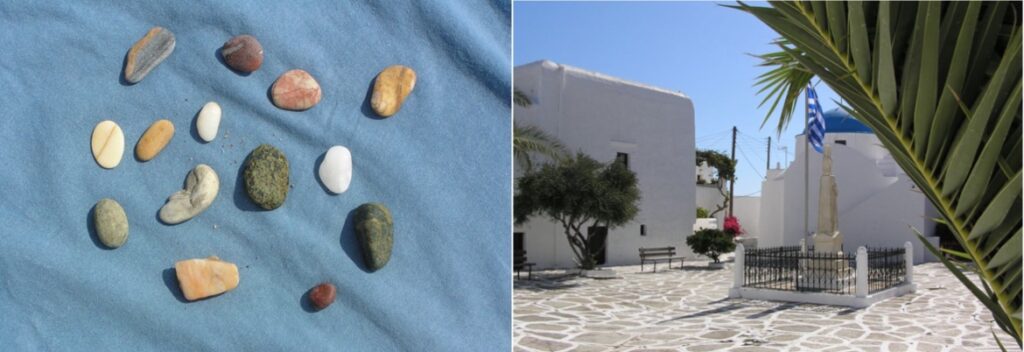
Practicalities
Getting There: In September, the season is coming rapidly to a close. There are two boats a week from Piraeus and possibly one from Lavrion (Attica.) However, 14 ferries a week come to Sikinos, so hopping to/from better-connected islands is a possibility.
Home Base: Decide where you want to be—Alpronia, the port; or Kastro-Hora, the capital. If you want easy access to a fine-sand beach gently sloping into the sea, with facilities for children, benches, umbrellas, the shade of tamarisk trees and a pair of resident ducks; if you enjoy the spectacle of ferries coming in; if you love waterside tavernes and bars and watching fishermen about their business—choose the port.
If you want to stay in one of the loveliest villages in the Cyclades, with whitewashed houses with bougainvillea, tavernes under grape-laden vines (in September), families of kittens playing in the car-free lanes, to be high above the sea with well-defined mule paths to all parts of the island and spectacular sunsets—choose the capital. (Also, you will find there the post office, the bank, ATM, health center, estate agent, ferry ticket office, butcher, baker, and general stores.)
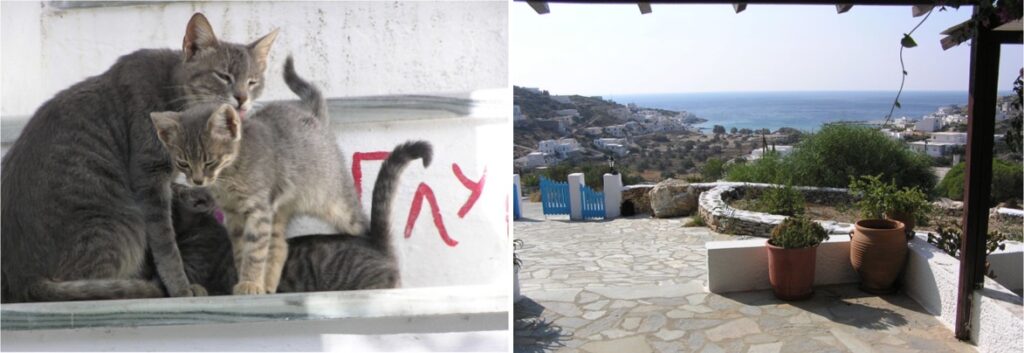
Transport: A sporadic bus service (driver’s car used out of season) runs between the port and the village. There is a printed timetable, which is occasionally adhered to. The only guarantee of service is in the village half an hour before a ferry is due, or at the port when it comes in. If you want to find rooms in the village, hop on the bus.
Getting Your Bearings: On arrival, buy from Flora’s store the excellent Topo 25 island map. It not only gives all the island’s many footpaths, it grades them with advice to the hiker. If you intend to walk the paths, never wear shorts (unless accompanied by thick, knee-length socks), nor skirts, nor flimsy footwear.
Lodging: Islanders will meet the boat, even in the middle of the night, with offers of accommodation. The Lucas Studios are good value. With taverna and café prices in Greece going through the roof (especially for Brits, with the pound plummeting), self-catering may be a good option.
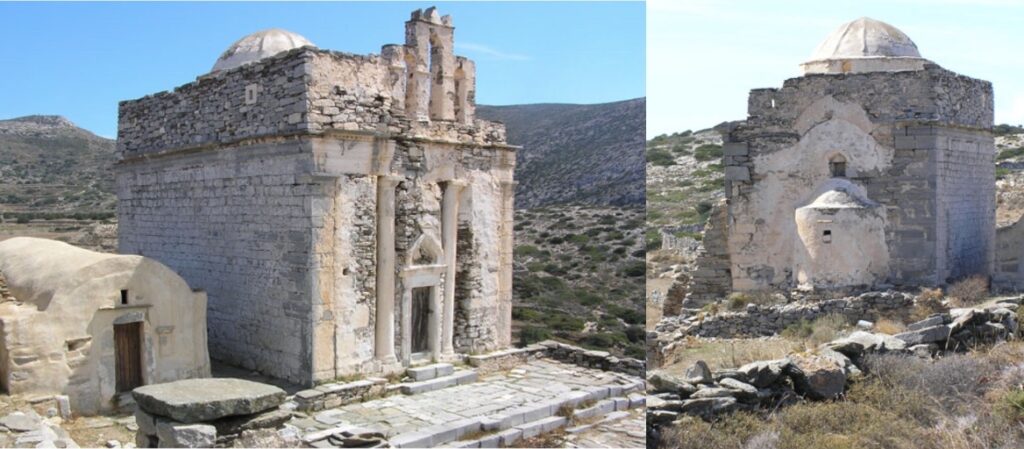
What to do: Walk, swim, sleep, eat, drink, talk, watch cats/yachts/sunsets/other sunbathers. This is not an island for thrill-seekers. There are two sites:
Episcopi: An hour’s walk from the village (occasional buses in season), this is a peculiar structure on a plateau below a hill with the faint remains of the original settlement before the island was deserted in the Middle Ages. It was thought to be a temple to the Pythian Apollo, dated by Bent from an inscription he saw, to the 2nd century BCE. Another view is that it was a shrine incorporating a family vault. It was turned into an Orthodox church in 1673, which accounts for its state of preservation—no carrying away of stone for other building work. It is picturesque and worth a visit, but locked. An excellent description may be found in Bent’s book.
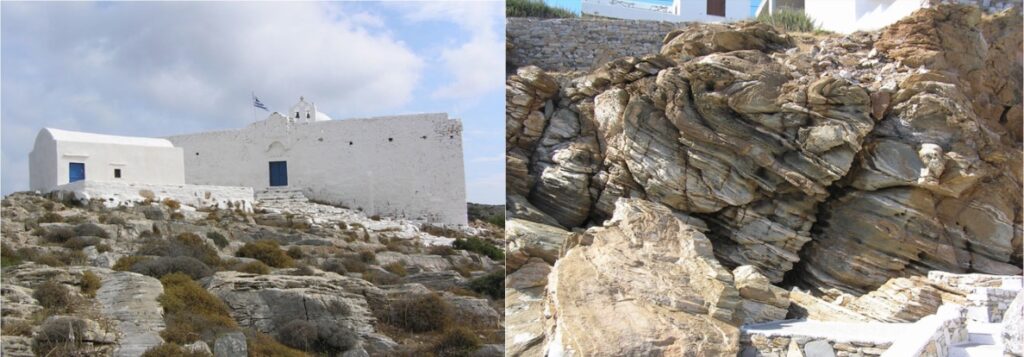
The Monastery of Zoodochos Pigis or The Life-Giving Spring, looks more like an adobe fortress from the American Southwest, with a distinct resemblance to The Alamo. Its fortifications have given it and the village below it the name “Kastro.” A steep climb, during which friendly cats will weave themselves around your ankles, will be rewarded by stunning views over many surrounding islands and, at dusk, sunset over Milos. It is locked, but a caretaker is reputed to open it in the evenings in season.
Beaches: The many virtues of Alpronia Beach have already been touched upon. Its only fault is that it is right by the port and very public. Behind the Port Authority building is a secret place for swimming off the rocks. A brand-new road runs to Aghios Georgios Beach, sand and beautiful pebbles, with a seasonal taverna. Dialiskari Beach is walkable from the port, but nothing special. Other beaches, notably Maltas, may be reached by boat in season or by an ankle-cracking walk at other times. This is not an island for spectacular beaches.

There is reputed to be an olive press museum, open on summer evenings, in the village, but I could not locate it. Otherwise—make your own entertainment. One of the unexpected delights of walking the paths, at least in September, is a profusion of orchid-like flowers among the browns, greys, and deep greens of the landscape. They are star-shaped, with six petals of white, delicately flecked with purple. They lift the spirits as one trudges along an especially stony path. The walker will also see many blue beehives on the hillsides.
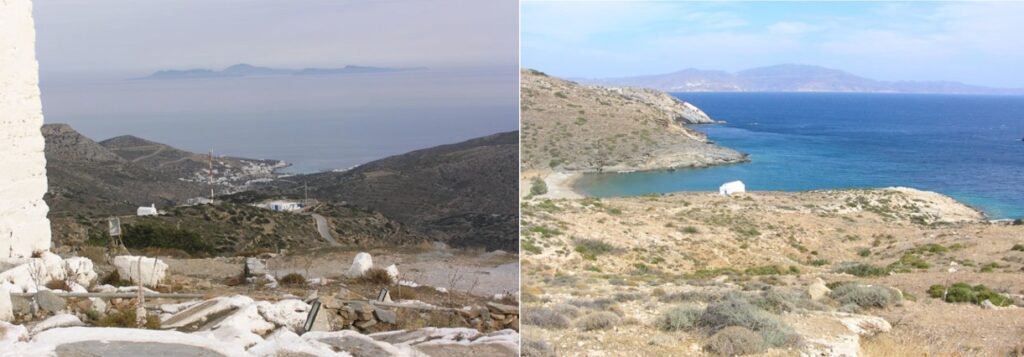
Tourism is a strand, but not a major one, in the island’s economy. It dominates for three months of the year, before the islanders return to the core activities of agriculture, fishing, and animal husbandry. For them, tourism is a servant, not a master. Thus, a visit to Sikinos gives a flavor of Cycladic island life 30 or 40 years ago. The people are prosperous, hospitable; determined to keep their island the way they like it.
A picture of Sikinos in the early 1960s comes from Captain H.M. Denham’s book The Aegean, published in 1963. He described the port thus: “A small taverna and one or two small houses are on the quay, and there is a freshwater well 200 yards inland. Provisions must be obtained from the main village on the hill.”
Kastro-Hora was “. . . a village of 700 people. It is less than an hour’s walk along an easy mule road and is worth the effort . . . . The population in 1960 was 800, nearly all of whom live in the one village. They are largely employed in cultivating the terraced vineyards and corn fields which cannot be seen from seaward.” Not much seemed to have changed from the time of the Bents’ visit 80 years earlier.
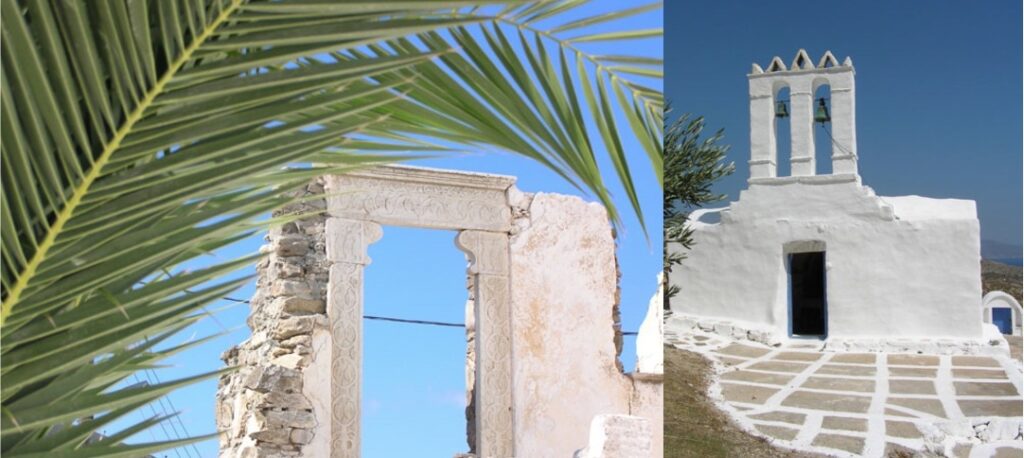
The tourist map of Sikinos describes the island with pride as “unsung,” and “a minimalist canvas composed of few but authentic elements.” (!) It also says this: “. . . keep in mind that the preservation of this island’s quiet charms is as much the responsibility of its visitors as it is the locals’, who must strike a careful balance between satisfying the needs of their guests and avoiding unrestrained development.”
Amen to that. So far, they have the balance spot on.

3 Comments
tburriss
let,s go to Sikinos for a month
David B
Just been to Sikinos. Episcopi is open and has been recently excavated and the remains of a female found along with grave goods. So it seems the original building was some kind of mausoleum for a remarkable woman? There is a truly inspirational man in charge of intepretations fo the visitor (Costas), I don’t know his family name. There is a video and he is a fount of information. There is a nice footpath from Chora and this site was the highlight of my trip, partly because I arrived at 14.45 15 minutes before closing time and was still there at 4pm with my wife and Costas whose enthusiasm was infectious. I will return as there were parts of the islands that I have not yet seen. The footpaths are well marked and it was a joy to walk in the late September sunshine to Malta, Ag Georgios and St Pandeliemas beaches.
Michael House
I’m so glad this picturesque structure is being properly excavated and opened to the public, although I rather liked its enigmatic aspect. I just hope they don’t build an unnnessary road to it.